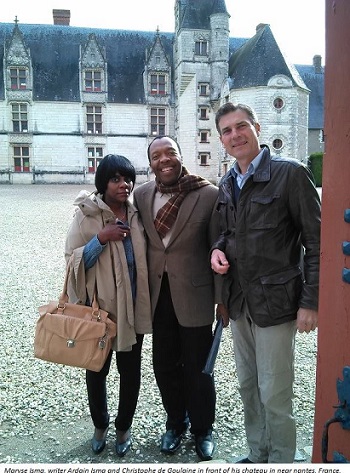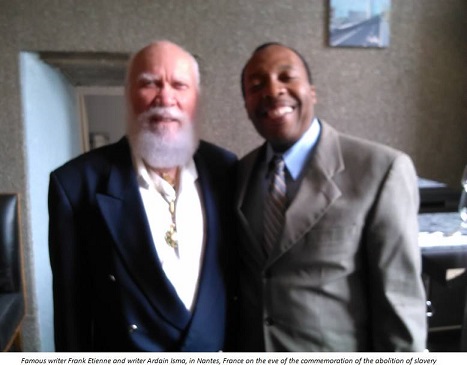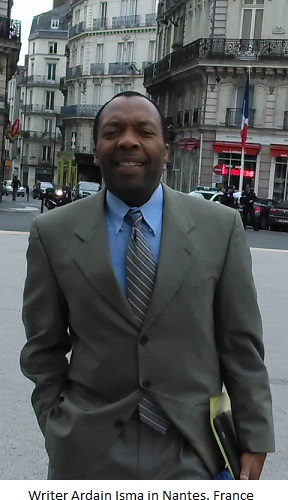CSMS Magazine
My recent trip to Europe was quite a thrill. It was a professional undertaking as well as a cross-cultural awareness journey. I was part of a Jacksonville’s Sister City Association delegation traveling to Nantes, France to join this beautiful French city in celebrating the international week of flowers and biodiversity. My wife, Maryse, was also an integral part of the delegation, and it was a double thrill to have such a lovely companion. We left Jacksonville on Monday May 5th. When we landed at the Charles De Gaulle International Airport, it was 6 o’ clock in the morning, the next day. Of course, the 6-hour difference between Eastern Standard Time and Paris’ time did nothing to help my body which clearly needed some rest.
Because our main destination was Nantes, we had to take a small transit train within the airport to reach the Railway Station. For some odds reasons, when we got there, we found out we had just missed the train going to Nantes. The next one would not come until another three hours.
Already, I could see the disappointment on Maryse’s face. The place was cold, loud and crowed. In the middle of this commotion, we had to find a comfortable place to wait. So, we walked to a petit restaurant on the far-end and ordered hot chocolate and baguette. I struggled to drink my chocolate. So, did Maryse. Our bodies needed some rest. An eight-hour flight had taken its toll.
Finally, the long wait had reached its end. We got on the train and off to Nantes, we went. It was the first time I took this train in early spring, and L’Ile- de- France, as the region is called, was in full bloom. The train ran into densely cultivated wheat fields and pines du colza used for cooking oil, and on both sides of the road, clusters of farms houses stood erect in what is clearly a picturesque valley. That reminded me of the road from Montreal to Quebec City. Soon, we came to the vast Région Parisienne which seemed endless. The city sprawled all around.
At last Paris was behind us, and the train rode in high speed through dark tunnels, thick forests, blue fields and exotic villages with corrugated rooftops. I met friendly Sylvaine, an older woman from the Paris 16th District with a peculiar smile and a big heart. She was in route to visit a friend in Rennes, the capital of Brittany. She was kind enough to give me everything I needed to know along the way. It was a thrill when we entered the Pays De La Loire, and the industrial town of Le Mans on the banks of the Sarthe River was right there. With awe, I watched the locals mingling with tourists in Cité Plantagenêt, the old town. We had to get off to catch another train going to Nantes, and Sylvaine went on to Rennes. We said goodbye with a bisou on each cheek. As I always have said, good people are found everywhere.
Another 30-minutes ride took us to the Loire Valley ever greener, ever prettier where mansions and châteaux perched on hilltops overlooking picturesque, blue fields with an intricacy of tiny villages. It didn’t take long when we pulled through La Gare De Nantes—the railway station. Immediately after we exited the train, we were greeted by Christine Renard and Sophie Jacquet, two important members of the Nantes Sister City’s Association. Two gifts from the City of Nantes were handed to us to officially welcome us into town.
We got on their car, and we rode in full speed, passing through the beautiful park of Jardin des Fleurs and soon rolled towards the Château du Duc de Bretagne. There, Sophie suggested that we go in to meet other members in a tour inside the château which has long been converted into a museum. Maryse and I declined. We needed to find a bed, and the ladies understood. So, we maneuvered to Sophie’s beautiful apartment near the center of Nantes in the middle of sidewalk cafés where we were housed for the stay.
 The next morning, after le petit déjeuner (breakfast), Sophie took us to a stunning ride on the east bank of the Loire River and in Haute-Goulaine to go visiting Christophe, the procurer du Château de Goulaine and his brother Mathieu, le marquis de Goulaine in their imposing castle which has been the home of this family for over thousand years. Vineyards precede the honorary entrance of the château as Sophie navigated down the gravel pathway that lead to the historic castle.
The next morning, after le petit déjeuner (breakfast), Sophie took us to a stunning ride on the east bank of the Loire River and in Haute-Goulaine to go visiting Christophe, the procurer du Château de Goulaine and his brother Mathieu, le marquis de Goulaine in their imposing castle which has been the home of this family for over thousand years. Vineyards precede the honorary entrance of the château as Sophie navigated down the gravel pathway that lead to the historic castle.
At the entrance, we met a smiling Christophe in black leather jacket, happy to greet new members of the Jacksonville delegation. We chatted a little bit and then he ordered one of his tour guides to give us a tour. Sophie suggested that she be the one to give us the tour since she is familiar with the place. We could not wait for long because Wednesday was a day of intense activities in town. It was the day that marked the official start of the Floralies. About an hour later, we left the château and headed straight to the City Hall for an official lunch organized by the Mayor’s Office. At the City Hall, we were reunited with the rest of delegation. It was also an opportunity to meet members of other delegations from across the globe. The lunch was classy à la cuisine française. Dignitaries from all corners of Nantes were present.
After the official lunch, everyone left the City Hall, walking through the center of town on their way to the Sèvre River where we all boarded a small cruise ship that took us to Grand Floralies Expo at Parc De Beaujoire in an upscale suburb, not far from the University of Nantes. There, we were welcomed by Monsieur Eugène Boussaud, president of the Floralies Internationales de Nantes, who stressed the emphasis of saving our planet through the promotion of green environments. Madame Johanna Rolland, the young socialist Mayor soon walked onto the podium to reinforce monsieur Boussaud. Then we walked to the exposition hall, where for the first time in my life I was an eyewitness to so many exotic flowers. Tons of floral-stands were well crafted, beautifully arranged, and each stand represented a city or region of the world. It took my breath away. Most major cities of the world were represented, including New York, Tokyo, Durbin (South Africa) etc…. At some point, I thought I had reached Paradise.
Maryse was getting tired, so we went back to our apartment to rest a little. We needed to rest for a sophisticated gala at the Beaujoire later that evening. The dress code was rigorously enforced, and the dinner was sumptuous. Maryse dressed in a glittering purple gown was truly beautiful. Elle était l’une des plus belles. (She was one of the prettiest ladies).
Commemorating the abolition of slavery in Nantes
 While this was going on, there was an expo on the abolition of slavery, honoring the historic role of Haiti in breaking the backbones of this gruesome period in history. Lots of artists and writers, Frankétienne among them, were invited for the event which started on May 10th and will last until the end of the summer. The emphasis was/is on Haiti—its culture and its history. On Friday May 9th, Frankétienne was the guest of honor at the exposition on slavery near Downtown Nantes. Frank spoke candidly about the role of Haiti in its struggle to eradicate slavery. A day earlier, Frank and I met at Les enfants terribles, a modest restaurant near the City Hall where we chatted and took a couple snapshots together.
While this was going on, there was an expo on the abolition of slavery, honoring the historic role of Haiti in breaking the backbones of this gruesome period in history. Lots of artists and writers, Frankétienne among them, were invited for the event which started on May 10th and will last until the end of the summer. The emphasis was/is on Haiti—its culture and its history. On Friday May 9th, Frankétienne was the guest of honor at the exposition on slavery near Downtown Nantes. Frank spoke candidly about the role of Haiti in its struggle to eradicate slavery. A day earlier, Frank and I met at Les enfants terribles, a modest restaurant near the City Hall where we chatted and took a couple snapshots together.
On Saturday, the city of Nantes paid the official tribute to Haiti by commemorating 210 years of independence. The new mayor, Johanna Rolland accompanied by some Haitian artists including Erol Josué, voodoo priest, author, composer, singer, dancer and Haitian writer Yanick Lahens walked through the center of town on their way to the Loire River where they symbolically threw flowers at the river in respect for all victims of slavery. An open-air exhibition on the history of the first black republic of the world can be seen until September 15 on the forecourt of the Memorial to the abolition of slavery.
Also on Saturday, I understood François Guillaume, Martelly representative and self-proclaimed Haitian Minister of Haitians Living Abroad spoke at an official visit by French President François Hollande. I never met this man, and his presence was quite insignificant, knowing the low rating Hollande currently enjoys in public opinion.
We can understand why Nantes is taking the lead in this effort in Europe. During the colonial era, the city benefited greatly from the slave trade. Here is what the committee for the abolition of slavery officially stated:
“Although Nantes was not the only French port to have taken part in the slave trade (Bordeaux, Rouen, La Rochelle, Brest, Lorient and Vannes also sent expeditions), it certainly pioneered the trade: between 1707 and 1711, 75% of the ships carrying slaves were from Nantes. The principal ship-owners in Nantes were Michel, René and Jean Montaudoin, Luc Shiell, Marthurin Joubert, Jean Terrien and Sarrebouse d’Audeville. Nantes was responsible for 50% of the human traffic, a percentage which grew again in 1762, before sinking to 32% between 1782 and 1792. In total, during the 18th century the port at Nantes sent out ships with 450,000 Africans, equivalent to 42% of the French slave trade. Nantes remained the principal slave port until the 1780s. Even after the official end of the slave trade in 1818, the trade continued. Over the next 13 years, 305 expeditions are recorded as having left from Nantes docks for the African coast.”
This is a contrition that many think could salvage the city’s ugly history with regards to two centuries of slave trade.
Then, we went off to Paris, where we met some other colleagues and old friends like Frankel Thienne, Gérald Bloncourt etc… Thienne, a humble gentleman, took times out of his busy schedule to drive us around in his beautiful Mercedes Benz and then invited us to his lovely home right outside Paris for a sumptuous dinner prepared by his lovely wife Lucienne.
Bloncourt invited us also for dinner at his home on the 12th District. We spent a wonderful afternoon with Gérald, his wife Isabelle and daughter Morgane. At 88, the Dean of the Haitian left is going stronger and stronger. His voice, his conviction and passion for Haiti is a thrill to observe. We were supposed to go to Luxembourg the next day, but Gérald couldn’t wait. He felt compelled to give us a sneak preview of his speech about the deploring condition of Haiti and the lack of interest from the country’s leaders to help Haiti land on its feet.
Lots of events in Luxembourg
In Luxembourg, the entire month is devoted to Haiti. The richest city/country of Europe is bowing before the effort of the Haitian people to rid themselves from the grip of foreign influence. Lots of artists, researchers, writers have rendezvoused in Luxembourg for the events. Among them were Beethova Obas, Emeline Michel, Louis–Philippe Dalembert, Hans Christophe Buch (German-Haitian), Gérald Bloncourt, film maker Anorld Antonin, Haitian jazz diva Géraldine Battesti etc…From Luxembourg, there is one slogan: Tout le monde au boulot pour Haiti. (Everyone, get to work on behalf of Haiti.)
In the humanitarian front, some NGO Luxembourgeoises are operating in Haiti. We understand the Haitian Embassy in Brussels was one of the sponsors, but many events in Luxembourg wanted no part with the current regime in Port-au-Prince.
Returning to Paris, I found the city as vibrant as it has ever been. Although, it rained almost every day while I was in Europe, I believe spring is the perfect season of the year to visit. It’s cool, it’s green and it’s blooming. For more info on the Luxembourg events, one can visit www.ccrn.lu
Note: Dr. Ardain Isma is the chief-editor for CSMS Magazine. He teaches Cross-cultural studies at University of North Florida. He wrote this piece while in tour in Europe. He may be reached at publisher@csmsmagazine.org
More Pictures about the trip can be found on our Facebook fan Page: www.facebook.com/csmsmagazine


